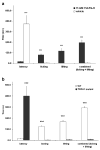Roles of transient receptor potential channels in pain
- PMID: 19203589
- PMCID: PMC2683630
- DOI: 10.1016/j.brainresrev.2008.12.018
Roles of transient receptor potential channels in pain
Abstract
Pain perception begins with the activation of primary sensory nociceptors. Over the past decade, flourishing research has revealed that members of the Transient Receptor Potential (TRP) ion channel family are fundamental molecules that detect noxious stimuli and transduce a diverse range of physical and chemical energy into action potentials in somatosensory nociceptors. Here we highlight the roles of TRP vanilloid 1 (TRPV1), TRP melastatin 8 (TRPM8) and TRP ankyrin 1 (TRPA1) in the activation of nociceptors by heat and cold environmental stimuli, mechanical force, and by chemicals including exogenous plant and environmental compounds as well as endogenous inflammatory molecules. The contribution of these channels to pain and somatosensation is discussed at levels ranging from whole animal behavior to molecular modulation by intracellular signaling proteins. An emerging theme is that TRP channels are not simple ion channel transducers of one or two stimuli, but instead serve multidimensional roles in signaling sensory stimuli that are exceptionally diverse in modality and in their environmental milieu.
Figures















Similar articles
-
TRP channels and analgesia.Life Sci. 2013 Mar 19;92(8-9):415-24. doi: 10.1016/j.lfs.2012.08.010. Epub 2012 Aug 14. Life Sci. 2013. PMID: 22910182 Free PMC article. Review.
-
Endogenous Inflammatory Mediators Produced by Injury Activate TRPV1 and TRPA1 Nociceptors to Induce Sexually Dimorphic Cold Pain That Is Dependent on TRPM8 and GFRα3.J Neurosci. 2023 Apr 12;43(15):2803-2814. doi: 10.1523/JNEUROSCI.2303-22.2023. Epub 2023 Mar 10. J Neurosci. 2023. PMID: 36898840 Free PMC article.
-
TRP Channels in Nociception and Pathological Pain.Adv Exp Med Biol. 2018;1099:13-27. doi: 10.1007/978-981-13-1756-9_2. Adv Exp Med Biol. 2018. PMID: 30306511 Review.
-
How cold is it? TRPM8 and TRPA1 in the molecular logic of cold sensation.Mol Pain. 2005 Apr 22;1:16. doi: 10.1186/1744-8069-1-16. Mol Pain. 2005. PMID: 15847696 Free PMC article. Review.
-
TRP channels: targets for the relief of pain.Biochim Biophys Acta. 2007 Aug;1772(8):989-1003. doi: 10.1016/j.bbadis.2007.01.008. Epub 2007 Jan 23. Biochim Biophys Acta. 2007. PMID: 17321113 Review.
Cited by
-
Structure of thermally activated TRP channels.Curr Top Membr. 2014;74:181-211. doi: 10.1016/B978-0-12-800181-3.00007-5. Curr Top Membr. 2014. PMID: 25366237 Free PMC article. Review.
-
Effect of a temperature increase in the non-noxious range on proton-evoked ASIC and TRPV1 activity.Pflugers Arch. 2011 Jan;461(1):123-39. doi: 10.1007/s00424-010-0884-3. Epub 2010 Oct 6. Pflugers Arch. 2011. PMID: 20924599
-
Antinociception by the anti-oxidized phospholipid antibody E06.Br J Pharmacol. 2018 Jul;175(14):2940-2955. doi: 10.1111/bph.14340. Epub 2018 Jun 7. Br J Pharmacol. 2018. PMID: 29679953 Free PMC article.
-
Advances with Long Non-Coding RNAs in Diabetic Peripheral Neuropathy.Diabetes Metab Syndr Obes. 2020 Apr 30;13:1429-1434. doi: 10.2147/DMSO.S249232. eCollection 2020. Diabetes Metab Syndr Obes. 2020. PMID: 32431526 Free PMC article. Review.
-
Atractylodes macrocephala Koidz Alleviates Symptoms in Zymosan-Induced Irritable Bowel Syndrome Mouse Model through TRPV1, NaV1.5, and NaV1.7 Channel Modulation.Nutrients. 2024 May 29;16(11):1683. doi: 10.3390/nu16111683. Nutrients. 2024. PMID: 38892616 Free PMC article.
References
-
- Bandell M, Story GM, Hwang SW, Viswanath V, Eid SR, Petrus MJ, Earley TJ, Patapoutian A. Noxious cold ion channel TRPA1 is activated by pungent compounds and bradykinin. Neuron. 2004;41:849–857. - PubMed
Publication types
MeSH terms
Substances
Grants and funding
LinkOut - more resources
Full Text Sources
Other Literature Sources
Medical
Miscellaneous

